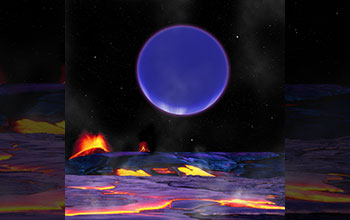Multimedia Gallery
Newly discovered two-planet system of Kepler-36
In this artist's conception, a "hot Neptune" known as Kepler-36c looms in the sky of its neighbor, the rocky world Kepler-36b. The two planets have repeated close encounters, experiencing a conjunction every 97 days on average. At that time, they are separated by less than five Earth-moon distances. Such close approaches stir up tremendous gravitational tides that squeeze and stretch both planets, which may promote active volcanism on Kepler-36b.
More about this image
In 2012, a team of researchers announced their discovery of the two-planet system of Kepler-36 after examining data from NASA's Kepler spacecraft.
The system contains two planets circling a subgiant star much like the sun except several billion years older. The inner world, Kepler-36b, is a rocky planet 1.5 times the size of Earth and weighing 4.5 times as much. It orbits about every 14 days at an average distance of less than 11 million miles. The outer world, Kepler-36c, is a gaseous planet 3.7 times the size of Earth and weighing eight times as much. This "hot Neptune" orbits once each 16 days at a distance of 12 million miles.
The two planets experience a conjunction every 97 days on average. At that time, they are separated by less than 5 Earth-Moon distances. Since Kepler-36c is much larger than the Moon, it presents a spectacular view in its neighbor's sky. (Coincidentally, the smaller Kepler-36b would appear about the size of the Moon when viewed from Kepler-36c.) Such close approaches stir up tremendous gravitational tides that squeeze and stretch both planets.
Researchers are struggling to understand how these two very different worlds ended up in such close orbits. [Research supported in part by a grant from the National Science Foundation.]
To learn more about this research, see the NSF News From the Field story Planetrise: Alien world looms large in its neighbor's sky. (Date image taken: June 2012; date originally posted to NSF Multimedia Gallery: Dec. 26, 2017)
Credit: David A. Aguilar/Harvard-Smithsonian Center for Astrophysics
Images and other media in the National Science Foundation Multimedia Gallery are available for use in print and electronic material by NSF employees, members of the media, university staff, teachers and the general public. All media in the gallery are intended for personal, educational and nonprofit/non-commercial use only.
Images credited to the National Science Foundation, a federal agency, are in the public domain. The images were created by employees of the United States Government as part of their official duties or prepared by contractors as "works for hire" for NSF. You may freely use NSF-credited images and, at your discretion, credit NSF with a "Courtesy: National Science Foundation" notation.
Additional information about general usage can be found in Conditions.
Also Available:
Download the high-resolution JPG version of the image. (4.8 MB)
Use your mouse to right-click (Mac users may need to Ctrl-click) the link above and choose the option that will save the file or target to your computer.



